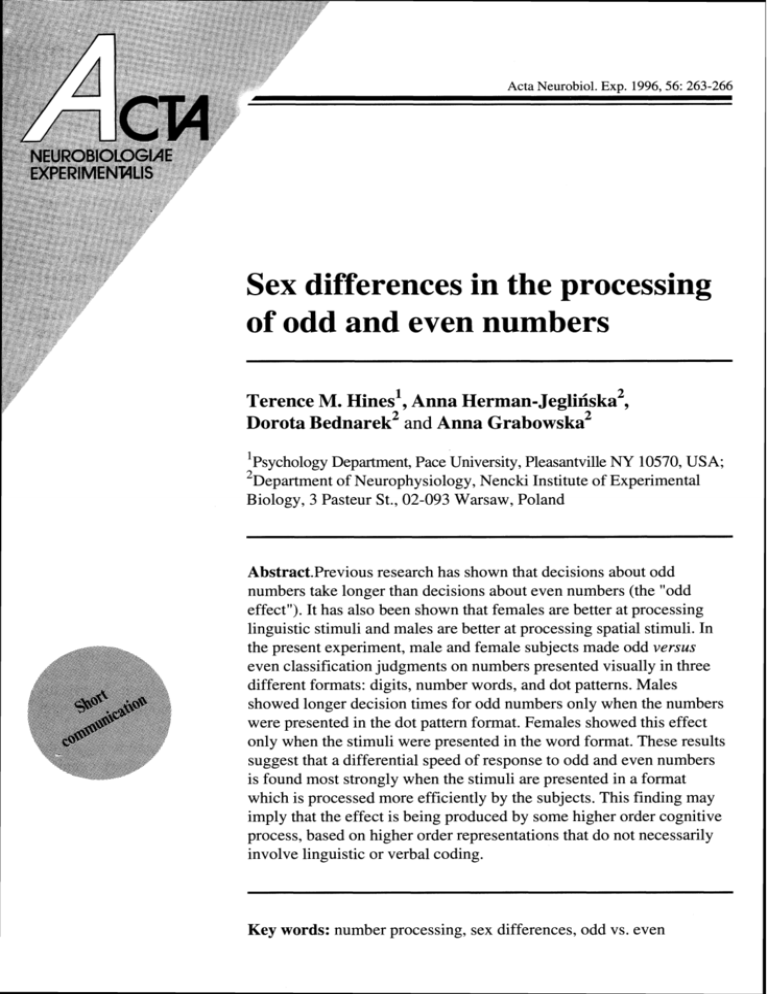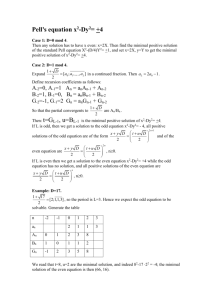
Sex differences in the processing
of odd and even numbers
Terence M. Hinesl, Anna Herman-~ e ~ l i r i s k a ~ ,
Dorota ~ e d n a r e kand
~ Anna ~ r a b o w s k a ~
' ~ s ~ c h o Department,
lo~~
Pace University, Pleasantville NY 10570, USA;
2~epartmentof Neurophysiology, Nencki Institute of Experimental
Biology, 3 Pasteur St., 02-093 Warsaw, Poland
Abstract.Previous research has shown that decisions about odd
numbers take longer than decisions about even numbers (the "odd
effect"). It has also been shown that females are better at processing
linguistic stimuli and males are better at processing spatial stimuli. In
the present experiment, male and female subjects made odd versus
even classification judgments on numbers presented visually in three
different formats: digits, number words, and dot patterns. Males
showed longer decision times for odd numbers only when the numbers
were presented in the dot pattern format. Females showed this effect
only when the stimuli were presented in the word format. These results
suggest that a differential speed of response to odd and even numbers
is found most strongly when the stimuli are presented in a format
which is processed more efficiently by the subjects. This finding may
imply that the effect is being produced by some higher order cognitive
process, based on higher order representations that do not necessarily
involve linguistic or verbal coding.
Key words: number processing, sex differences, odd vs. even
264
T.M. Hines et al.
It has been shown under a variety of conditions
that subjects make judgments about odd digits more
slowly than they make the same judgment about
even digits (Hines 1990). Specifically, when subjects perform a sameldifferent judgment task in
which non-identical pairs of odd (i.e., 7 5) and even
(i.e., 6 2) digits are both to be judged as "same," reaction time to judge the odd pairs as same is approximately 100 ms longer than the time needed to
judge a pair of even digits as same. The effect is not
limited to sameldifferent judgments, but is also
found in classification tasks. That is, when pairs of
non-identical digits must be classified as either both
even or both odd, classification is longer for the odd
digit pairs. This effect is also present when a single
digit is classified as being odd or even, although
Hines (1990) found the effect for single digits in
error rate, not reaction time. The effect is not due to
a strategy of testing whether a digit is even before
testing whether it is odd. Hines et al. (in preparation)
varied the proportion of odd and even digits across
trial blocks and still found slower responses to odd
digits in a block where the great majority of digits
was odd. Nor is the effect due to a quirk of the English language such that the word "odd" means not
only "not divisible evenly by two" but also "strange
or unusual." This is not the case in Polish and non-English speaking Polish subjects also show a substantial slowing of responses to odd digits (Hines et
al., in preparation).
Hines (1990) suggested that the odd effect might
be due to the linguistically marked nature of the
concept "odd", the concept "even" being unmarked.
There is evidence in the psycholinguistic literature
(Zirnrner 1964, Sherman 1976, Skowronski and Yan
1992) that marked concepts take longer to process
than unmarked ones. Following this logic, Hines
(1990) showed that subjects took longer to make
judgments about names of non-living (a marked
concept) as opposed to nvnes of living (an unmarked concept) objects. This was found even though
the names were equally frequent in the language.
If the odd effect is due to the linguistic nature of
the internal representation activated by the stimuli
presented, then the size of the effect would be ex-
pected to vary as a function of the degree to which
the specific stimuli used activate a specifically linguistic internal representation. Thus, it would be expected that a greater effect would be seen with word
stimuli than with digit stimuli. And a greater effect
should be seen with digit stimuli than with some
even more non-linguistic stimulus type, such as dot
patterns. Further, more efficient linguistic processors might be expected to show the effect to a
greater degree than less efficient linguistic processors. There is literature suggesting that females are
better at linguistic tasks than males (Halpern 1992,
Kimura 1992) while males are better than females
at tasks involving spatial processing (Linn and
Petersen 1985, Kimura 1992). To the extent that this
is the case, it would be expected that females would
show a greater slowing of responses to odd digits
than would males. Further, the degree of slowing
should also vary as a function of the specific stimulus
formats used to represent the number being judged
with more linguistic stimuli generating a greater slowing. We tested these hypotheses by using three different formats (number words, digits and dot patterns) in
a task in which male and female subjects made an odd
versus even classification of a single stimulus.
Subjects were 12 male and 8 female right handed
university students with normal or corrected-tonormal vision. Stimuli were presented at the centre
of a 14 inch NEC video monitor connected to an
IBM PC 486 computer. Stimuli were the numbers
1 through 8, presented in three different stimulus
formats. Number words were presented vertically
and measured 40' of arc wide and from lo20' to 3'
high. Single digits measured 40' wide and l o 30'
high. Dot pattern stimuli were in the form of a die
face and measured 2' by 2'. All stimuli were centred
on the screen. Examples of the three stimulus formats are shown in Fig. 1.
A trial started with the central presentation of a
warning dot that was followed, 250 ms later, by the
stimulus for that trial. The stimulus remained on the
screen until the subject responded. Following a response, the stimulus was erased from the screen and
after a 1 s inter-trial-interval, the warning dot for the
next trial appeared.
Processing numerical stimuli
Fig. 1. Examples of three stimulus formats used in the experiment: digits,
- number words, and dot patterns.
Subjects responded by pressing one of two response keys to indicate whether the stimulus was
odd or even. Which key signalled which response
was counterbalanced across subjects. There was a
total of 240 trials, divided into three blocks of 80
trials each. In each block, each number was randomly presented 10 times. Trial blocks of each of the
three stimulus formats were counterbalanced across
subjects.
Table I shows the means and standard deviations
of reaction times for the three stimulus formats
265
broken down by odd and even type and by sex of
subject.
A three-way ANOVA (sex by stimulus format
by oddeven) was performed on these data. There
was a significant main effect of stimulus format
(F(2,18)=13.16; P<0.001). Neither the sex nor the
oddleven variable had a significant main effect on
reaction time. There was, however, a significant
three way interaction between the three variables
entered into the ANOVA (F(2,18)=3.96; P=0.028).
Decomposition of this interaction via the performance of two separate two way ANOVAs on the
data for male and female subjects showed a significant main effect of stimulus format for both male
(F(2,22)=13.85;Pe0.001) and female (F(2,14)=3.99;
P=0.041) subjects. The nature of this effect differed
for the two sexes, however. For females responses
to odd numbers were slower than responses the
even numbers only for the word format stimuli
(t(7)=2.86; P=0.024). For males, there wasn't a hint
of any such slowing for the word stimuli, but the effeet was significant only for the dot pattern stimuli
(t(11)=2.77; P=O.O18).
The results partly bear out the predictions made
at the beginning of this paper. Females showed a
significant slowing of responses to odd stimuli, but
only when stimuli were presented in the word format, the most directly linguistic format used in this
study. Males showed no such effect for word stimuli, but did show a slowing of responses to odd numbers when the numbers were presented in the dot
format. Thus, it appears that subjects in this study
showed the greatest slowing of responses when they
TABLE I
Means and standard deviations of reaction times to odd vs. even numbers presented in three different formats: digits, number
words, and dot patterns
Material
Females
Males
Digits
Mean
SD
Mean
SD
Dies
Words
Odd
Even
Odd
Even
Odd
Even
622
48
585
84
616
47
578
69
603
46
617
67
606
55
602
95
67 1
73
645
78
648
71
647
87
266
T.M. Hines et al.
were making judgments about the stimulus format
which they processed most efficiently. This finding
may imply that the effect is being produced by some
higher order cognitive process, based on higher
order representations that do not necessarily involve linguistic or verbal coding. Such a representation might be termed "supra-linguistic".
That we did not find an overall slowing of reaction time for judgments of word stimuli may appear
to contradict the findings of Hines (1990, experiment 5) in which a 20 ms slowing was found on this
type of task. However, in the subject pool Hines
used, the great majority of subjects were female, although the exact proportion was not reported for
that particular experiment. Given our present results, a high proportion of females in an experiment
would be sufficient to generate an overall slowing
of responses to names of odd digits.
Our findings support the general hypothesis that
there will be a greater effect of the oddleven variable when stimuli are presented to a processor specialized for the stimulus format used. There is a
huge literature showing that the.two hemispheres of
the human brain are differently specialized for processing different stimulus formats. This suggests
that the size of the difference in response times to
odd and even stimuli will vary as a function of
which hemisphere processes the stimuli. Our current research is investigating this possibility.
We thank K. Sutkowski for his technical assistance. This study was supported by statutable grant
to the Nencki Institute from State Committee for
Scientific Reasearch.
Halpern D. F. (1992) Sex differences in cognitive abilities.
2nd edition. Lawrence Erlbaum !lssociates, Hillsdale, NJ.
Hines T. (1990) An odd effect: letythened reaction times for
judgments about odd digits. Mem. Cogn. 18: 40-46.
Kimura D. (1992) Sex differences in the brain. Sci. Am. 267:
119-125.
Linn M.C., Petersen A.C. (1985) Emergence and characterization of sex differences in spatial ability; a meta-analysis. Child Dev. 56: 1479-1498.
Sherman M. (1976). Adjectival negation and the comprehension of multiply negated sentences. J. Verbal Learn. Verbal Behav. 15: 143-157.
SkowronskiT., Yan G. (1992) Cross-culturaltest of an asymmetry
of language knowledge dimensions: a Polish-Chinese
study. Polish Psychol. Bull. 23: 263-281.
Zimmer K. (1964) Affixed negation in English and other languages: an investigation of restricted productivity. Word
20: 5 no. 2.
Paper presented at the 2nd International Congress of the
Polish Neuroscience Society; Session: Learning, memory and
cognitive functions








